We’re watching the forecast warning of even more snowfall on the way, particularly Tuesday night into Wednesday. In the meantime, with some snow expected overnight tonight, school districts are starting to make their decisions. We haven’t heard from Highline Public Schools yet, but Seattle Public Schools has made its call – 2 hours late tomorrow. We’ll be watching HPS as well as other local schools; if you get word of a school change you don’t see here, please let us know – whitecenternow@gmail.com. Thanks!
White Center snow: Prepare for a bigger storm
January 16th, 2012 at 7:52 pm Posted in Highline School District, Weather, White Center news | Comments Off on White Center snow: Prepare for a bigger storm
Snowy Sunday, and more headed this way
January 15th, 2012 at 9:36 pm Posted in Weather, White Center news | Comments Off on Snowy Sunday, and more headed this way

(Another photo from Gill – during the snowy afternoon)
A few things you should know about Monday: Metro was already on “reduced weekday service” because of the MLK Day holiday, and now they’re staying on snow routes for the day, too. School, of course, is out for the day. More snow is considered to be likely in the afternoon, and then on Tuesday, but the major concern on Monday morning, for those who do not have the day off, will be icy roads/sidewalks, since the temperature is falling below freezing tonight.
White Center Weather Watch: Advisory for possible on-off snow all day
January 15th, 2012 at 9:32 am Posted in Snow, Weather, White Center news | 2 Comments »

(Thanks to Gill for the snow-on-glass-sphere view!)
Any at your house? The National Weather Service now has the area under a Winter Weather Advisory till 10 pm tonight – see it here, and stay safe! If the snow gets photogenic where you are, we always appreciate photos at whitecenternow@gmail.com.
Spectacular sunset and … will it really snow?
January 13th, 2012 at 7:18 pm Posted in White Center news | Comments Off on Spectacular sunset and … will it really snow?

Thanks to Gill for the North Highline/White Center view of tonight’s incredible sunset. It closes a day in which many wondered if we are really going to see snow, possibly as soon as tomorrow morning. Meteorologists think it’s likely. So the county sent out this info roundup:
The National Weather Service is forecasting cold weather and likely snowfall within the next several days. The King County Office of Emergency Management urges residents and businesses to prepare now for possible winter weather emergencies.
Before the weather turns bad, make sure your family, home, and vehicle are ready for whatever Mother Nature sends. The following guidelines can help you prepare.
Family
Listen to weather forecasts regularly and heed any warnings.
Make sure everyone knows when and how to call 9-1-1.
Make sure you understand the emergency plans and expectations at your child’s school and your work.
Check your emergency supplies and restock outdated items. Be sure to include plenty of water and non-perishable food, first aid supplies, a battery-operated radio, flashlight and extra batteries for both. A checklist can be found at www.TakeWinterByStorm.org.
If you have pets, bring them indoors. If you cannot bring them inside, provide adequate shelter to keep them warm and make sure they have access to unfrozen water.
Identify an out-of-state contact to call during a major disaster or emergency; it will be easier to call out of the area if local lines are tied up.
Your ability to feel a change in temperature decreases with age, and older people are more susceptible to health problems caused by cold. If you are over 65 years old, place an easy-to-read thermometer in an indoor location where you will see it frequently, and check the temperature of your home often during the winter months.
Monitor the weather forecast and adjust your travel plans if necessary. Know the snow routing for school buses and public transit.
Check on neighbors, especially anyone who might need help.
Subscribe to free regional alerts and news bulletins at www.rpin.org.Home
Be sure you have sufficient heating fuel for emergency equipment in case the electricity is cut off (such as a good supply of dry, seasoned wood for your fireplace or wood-burning stove).
Install a smoke detector and a battery-operated carbon monoxide detector. Test the batteries each month, and replace them twice a year.
Take steps to avoid carbon monoxide poisoning. Never use a generator indoors, in garages, or in carports. Never use a gas or charcoal grill, hibachi, or portable propane heater to cook indoors or heat your home. Avoid combustion “space heaters” unless there is an exhaust vent.
Insulate any water lines that run along exterior walls so your water supply will be less likely to freeze. To the extent possible, weatherproof your home by adding weather-stripping, insulation, insulated doors and storm windows, or thermal-pane windows.
Learn how to shut off water valves in case a pipe bursts.
Have your chimney or flue inspected each year.
Learn more tips for preparing your home at takewinterbystorm.org.Vehicle
Make sure your vehicle is properly serviced and maintained. Ensure the electrical systems, brakes, batteries, lights, windshield wipers, antifreeze and heating and cooling systems are in good shape. Check fluid levels – antifreeze, windshield washer, and oil.
Keep tires properly inflated and make sure they have adequate tread. Replace any worn tires.
Build, or restock, a vehicle emergency kit, including flares, flashlight, extra batteries, ice scraper, tire chains, a blanket and warm clothing, sturdy shoes, first-aid supplies, water, and non-perishable food. You can find a detailed list at takewinterbystorm.org.
Keep your gas tank at least half full; the extra gas helps reduce condensation that can plug your fuel line with ice and stall your engine in cooler weather. It also helps you avoid running out of gas if you experience long traffic delays.
When driving in snow, stick to major arterials. Register for road alerts at www.kingcounty.gov/roadalert and transit alerts at www.kingcounty.gov/transit.If snow piles up and roads become hazardous, postpone your trip if possible. Staying home will keep you and others safe. If you must travel, be aware of ice hazards, especially on shaded roadways, bridges, or in high elevation areas prone to freezing.
Hypothermia is a common problem during cold winter weather, especially with young children and older adults who are most vulnerable. Symptoms include uncontrolled shivering, slow or unclear speech, extreme tiredness, stumbling, confusion, semi-consciousness, or unconsciousness. If a person becomes unconscious, get medical help immediately. To prevent hypothermia, wear warm, multi-layered clothing with good head, hand, and foot protection. Avoid overly constricting wrist bands, socks, or shoes.
King County offices will be closed on Monday, January 16 for the Martin Luther King holiday. If closures or delays are necessary due to severe winter weather, they will be posted at kingcounty.gov and distributed by local media
Video: Victim’s family hopes for justice, as White Center murder suspect pleads not guilty
January 12th, 2012 at 9:39 am Posted in Crime, White Center news | 6 Comments »
We’re at the King County Courthouse downtown, where Cu Van Truong has just made his first appearance to answer the charge of first-degree murder in last month’s shooting at Seattle Roll Bakery. Truong is 25 years old and accused of murdering 24-year-old Jason Saechao in what court documents describe as an argument over jewelry and romance. Family members of the victim filled two rows in the courtroom.
During this morning’s brief hearing, Truong pleaded not guilty. Famliy members gasped and sobbed upon first sight of him walking into the glass-walled-off hearing area a few yards away from where they sat. Afterward, the victim’s aunt, Maeseng Chao, spoke with the media on behalf of the family, saying that today’s court hearing was the first time she had seen the victim’s mother cry. She said that they are having difficulty understanding why this happened, but she personally has faith in the justice system. We will add video from today’s hearing when we are back at HQ.
11:11 AM: We have added two video clips – first the hearing itself, less than two minutes long, which ended with a date set of January 26th for Truong’s next court appearance. The second is Jason Saechao’s aunt’s statement outside the courtroom after the hearing.
White Center Kiwanis invites you to Key Club fundraiser and ongoing meetings
January 12th, 2012 at 12:08 am Posted in White Center Kiwanis Club, White Center news | Comments Off on White Center Kiwanis invites you to Key Club fundraiser and ongoing meetings
White Center Kiwanis Club president Bill Tracy is really proud of the Key Club they now sponsor at New Start High School. After just a few months, he explains, “They have already completed one service project, which was to sell Christmas Holly Wreaths, which they made, for $5. They raised over $300, which they donated to the White Center Food Bank. Now they could use some help so they can pay their yearly dues and perhaps if we are really successful, pay for two students to attend the yearly Key Club convention, which is held in Seattle.” So here’s how you can help: The Key Club’s first annual fundraising baked-potato dinner is set for Thursday night, January 19th, at the school, 614 SW 120th, 6:30-8:30 pm, baked potato bar, salad, rolls, dessert, and beverages, only $10/ticket. You can pay at the door or call Bill at 206-248-2441 for advance tickets. He says there’ll be student entertainment, too.
As for the Kiwanis Club itself – you’re invited to its meetings on first and third Wednesdays, White Center Pizza and Spaghetti House (10231 16th SW), 12:30 pm. Bill says, “We are a service club and concentrate on helping children in our own community. We do food bank service once a month at night so those who work during the day can get food also. Also we have interesting speakers plus we honor a student from New Start High School each month.” Want to know more? Call Nancy Tracy – same number, 206-248-2441.
Two more chances for free emergency-preparedness classes at Salvation Army
January 11th, 2012 at 4:26 pm Posted in white center community safety coalition, White Center news | Comments Off on Two more chances for free emergency-preparedness classes at Salvation Army
Tonight and tomorrow are two more chances to learn about emergency preapredness – being ready to take care of yourself, your family, your business, no matter what – for free: 5-7 pm at the Salvation Army, with participants including the White Center Community Safety Coalition and West Seattle Be Prepared. There’ll be a mixer 3:30-5 pm there on Friday.
Boundary Review Board annexation hearing, night 2: There will be a night 3
January 10th, 2012 at 10:41 pm Posted in Annexation, Burien, White Center news | 7 Comments »
This first part will sound a lot like last night’s initial report: After a second three-hour of testimony, the Washington State Boundary Review Board for King County will meet for a third night – but no more public comment. You’re invited to their 7 pm January 23rd meeting at a location TBA, but it’s all about their deliberations, no more testimony. (Here’s who’s on the board, in case you wondered.) WCN co-publisher Patrick Sand recorded tonight’s meeting at White Center’s Cascade Middle School on video again and we’ll add that in the hours ahead, once it’s processed (unedited, but still takes time to upload). He says that after last night’s testimony was weighted toward opposition to Burien annexation of White Center and most of the rest of unincorporated North Highline, tonight’s went the other way, with more pro-annexation speakers than anti-.
Of note – this time around is VERY different than March 2009, when the Boundary Review Board’s hearing on the first Burien/North Highline annexation lasted for ONE night, less than two hours, and ended with a preliminary vote in favor of the proposal. Here’s our as-it-happened coverage from that night almost three years ago. Meantime, more to come on what happened tonight.
ADDED EARLY WEDNESDAY: The first video clip, almost 2 hours, includes all the Tuesday night testimony:
The second, a little more than an hour (following a break called by the board), includes the city of Burien’s rebuttal and replies to questions asked during the first night:
Traffic alert: 1st/Olson work this week
January 10th, 2012 at 7:56 pm Posted in Traffic, Transportation, White Center news | Comments Off on Traffic alert: 1st/Olson work this week
This might affect you, heading eastward toward Highway 509 the next few days. Announced today by the Seattle Department of Transportation:
Crews from the Seattle Department of Transportation plan to repair a hand rail this week on First Avenue (South) and Olson Place [map]. They will close the right lane of both streets at this location from 9 a.m. to 3 p.m. on January 11, 12 and 13. This work is subject to change in the event they are called to respond to an emergency at another location.
Video: Boundary Review Board annexation hearing, night 1 – There will be a night 2
January 9th, 2012 at 10:35 pm Posted in Annexation, White Center news | Comments Off on Video: Boundary Review Board annexation hearing, night 1 – There will be a night 2
The Boundary Review Board‘s hearing on Burien’s proposal to annex White Center (and other parts of unincorporated North Highline) will go to a second night tomorrow night. That’s the upshot after more than three hours. 7 pm at Cascade Middle School again. Tonight’s highlights to come.
ADDED 1:15 PM: We are processing our video (which we’ll publish unedited for those interested) covering most all of tonight’s hearing. (Added – here’s the first hour and a half; second one still processing.)
(Added – the second half of the meeting. Both clips are unedited – just the meeting, as it happened)
Meantime, toplines from co-publisher Patrick Sand, who was there for WCN:
MAJOR POINT: Burien city manager Mike Martin said that if the Legislature (which just convened this year’s session) kills the annexation tax credit for cities, Burien will stop right there.
OVERVIEW OF SPEAKERS: Most of the more than two dozen speakers the board heard from tonight voiced opposition to annexation; no one spoke in support until North Highline Unincorporated Area Council president Barbara Dobkin, the 13th speaker. She presented a letter from the council backing annexation. Other supporters included NHUAC member Ron Johnson, speaking as a private citizen, and Burien City Councilmember Jerry Robison. Opponents – including Burien City Councilmembers Lucy Krakowiak and Bob Edgar – cited concerns relating to the consultant’s report that Burien has used to project the cost of annexation, suggesting it was out of date, or too optimistic about the economy. Government reps who spoke, meantime, voiced support for annexation – Burien, King County, North Highline Fire District. For NHFD, Commissioner Liz Giba mentioned a few assurances the district would need, including job retention and pensions, and noted there are close to 200 acres that would remain unincorporated, including the “Sliver by the River,” so the board would need to give direction and seek a resolution of how those areas will be handled. (Seattle leaders have said that they are interested in pursuing annexation of the “sliver.”)
QUESTIONS FROM THE BOARD: They were interested in hearing from a member of the consulting team that put together the aforementioned report; Martin said he would try to make that happen. Also,, they asked what the level of social services would be post-annexation, and they wanted to hear from local law enforcement regarding the crime situation. Again, they’ll reconvene at Cascade tomorrow night, 7 pm.
Banner/posters appear at ex-Club Evo – but it’s not a sign of reopening
January 9th, 2012 at 9:23 am Posted in White Center news | Comments Off on Banner/posters appear at ex-Club Evo – but it’s not a sign of reopening
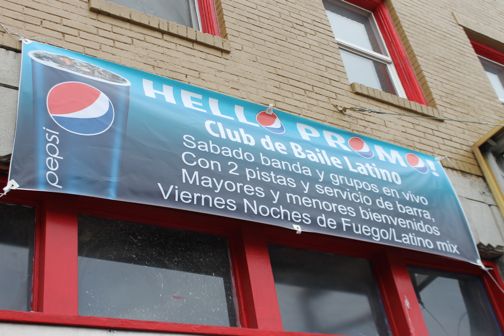
This banner that appeared on the former Club Evo(lucion) in downtown White Center turned some heads. But no, it does not portend another bid to reopen the controversial ex-nightclub space – which, as reported here previously, would run counter to the emergency moratorium passed last August anyway. It appears to be part of an attempt to let former Evo patrons know the proprietors’ new venture El Reventon at 7047 East Marginal Way (first mentioned here back in August) is now open. Posters on the storefront say the same thing:
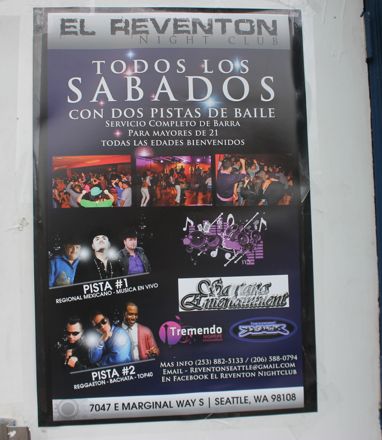
And the attempt to link the shuttered White Center property with the new East Marginal Way club is evident when you browse Facebook, where the page for El Reventon on East Marginal declared for last weekend, “Club Revolucion is back” … and an earlier update said “our new name is El Reventon Nightclub – Two dance floors of the best latin music – Now with a full service bar for 21+. All ages welcome, just 1 mile from our old White Center location.”
New website for Highline Public Schools
January 8th, 2012 at 10:58 pm Posted in Highline School District, Online, White Center news | Comments Off on New website for Highline Public Schools
Not sure exactly when the new look/location launched, but we looked at some Highline Public Schools webpages within the past few days and they didn’t have the new look or new domain. The district is finally at highlineschools.org and the website’s gotten an overhaul.
White Center weekend scene: Dubsea Bikes day
January 8th, 2012 at 5:38 pm Posted in Transportation, White Center news | Comments Off on White Center weekend scene: Dubsea Bikes day
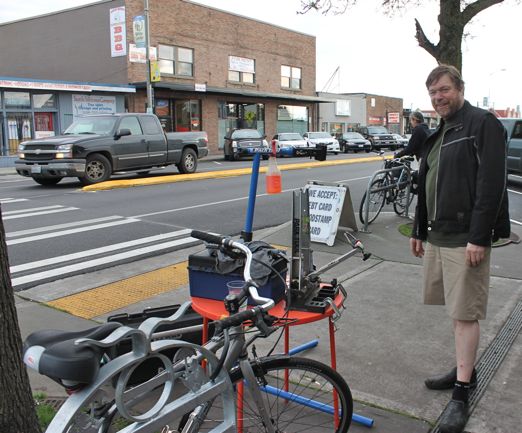
As mentioned earlier – today was another edition of Dubsea Bikes. We were in downtown WC checking out something else (story to come) and caught Stu Hennessey on camera just as things were getting under way. No rain, mild temperature, so a great day for 2-wheeling.
Live music at Dubsea Coffee today, 1-3 pm
January 8th, 2012 at 10:16 am Posted in Music, White Center news | Comments Off on Live music at Dubsea Coffee today, 1-3 pm
From Dubsea Coffee proprietor Sibelle – here’s who’s playing at her shop, 1-3 pm today:
AMORISTS AT LARGE
Starting in September of 2007, Amorists At Large is an acoustic act from Apple Valley, California, consisting of Gabriel Lopez on guitar and vocals, and Kyle Berryman on percussion and vocals. The amorists are fueled by nothing more than passion, and their love for music. They have a background of hardcore, and experimental sounds from an acoustic guitar, fused with a pair of voices that harmonize powerful words telling stories from the forgotten corners of the heart, explaining all parts of love. The parts we wish to forget and the others we never will.
From the WCN White Center Events Calendar: Free bike repairs today
January 8th, 2012 at 3:10 am Posted in White Center news | Comments Off on From the WCN White Center Events Calendar: Free bike repairs today
The goal: Get you on your bike, riding safely and smoothly. To help: Dubsea Bikes, with free repairs 2-4 pm today at Full Tilt Ice Cream in downtown White Center. Helping: Folks like Stu Hennessey from Alki Bike and Board in West Seattle. It’s on the new WCN White Center Events Calendar (see what else we have listed – go here).
Gardening 101: Start now, so you’ll have a new planting area in spring
January 7th, 2012 at 11:01 pm Posted in Gardening, White Center news | Comments Off on Gardening 101: Start now, so you’ll have a new planting area in spring

(After and before!)

By Vera Johnson of Village Green Perennial Nursery
Special to White Center Now
New garden beds over existing lawn: Skill level…Easy.
Have you been wanting to start a garden in an area of your yard, but it feels too overwhelming and you have no idea where to begin?
Do you have too much lawn to mow? Want to get rid of some of it?
Want to grow food and flowers? Growing perennial flowers is essential to healthy vegetable gardening, as the bees rely on the food source and the wasps that are attrracted to the plants are a predator to many of the bugs that attack vegetable starts … more on that later!
It’s really quite easy, but it does take some effort. Are you in? Willing? Then let’s go!!
Gather materials…this can take time, and that’s ok.
* Look around and see what you have to work with…rocks, concrete chunks from an old sidewalk or patio, wood rounds (preferably small diameter)
*Cardboard with tape and staples removed
*Newspaper…no shiny pages; the chemicals in the inks are not what we want for the gardens.
*Fallen leaves – there should be plenty in the neighborhood; ask your neighbors. Leaves (not all leaves are equal – see below) are a treasure trove of nutrients. You can also get free wood chips from a tree service; call ahead and have a place ready where they can dump, and you will get all the free mulch you can handle.
*Fertilizers (organic) with high nitrogen. Blood meal is great; bat guano; or fresh chicken manure if you have chickens – we’re not planting right away, so there’s no risk of burning the plants’ roots. I also LOVE to use KELP in this procedure, the soil benefits are spectacular.
1. Choose your location (think big, don’t limit yourself!) I like to use a garden hose to determine the border and have a visual aid for what the garden will look like.
2. Mow or weedwhack the area you’ve chosen (very, very short…leave the clippings for extra nitrogen)
3. Lay a heavy dose of nitrogen (fertilizer and/or manures) over the entire area you are planning to use as a garden; this will heat up under the layers we are about to put on the new garden and be ready in spring … patience.
4. On the chosen area for the new gardens, lay out cardboard so that it overlaps – or newspaper in thick layers, also overlapping – to prevent weeds from pushing up through. You are laying the paper or cardboard over the existing mowed lawn, and over the fertilizers.
5. Water the paper or cardboard to keep it from flying away. This is the stage where you can start heaping on the raked leaves. Birch, maple, oak, alder are the best leaves for this project.
You can also pile on any small branches and wood chips (not bark mulch, which is not a useful garden product, as it repels water – don’t get me started). You want the top layer to be at least 6 inches deep, more if possible. This will get the underground soil food web something to work on over the winter.
Come spring, you will be amazed at how loose and workable the ground is. You can expect to be able to stick the shovel in, right into the paper/cardboard; dig a hole, add fertilizer, soil amendment, and plant whatever you were planning to put in the garden.
Vera Johnson is proprietor of Village Green Perennial Nursery, and plans to share some gardening advice/secrets/info here from time to time. She writes about a variety of subjects at her own website – check it out here.
Health center’s move, ad-hoc library group, election delay @ North Highline Unincorporated Area Council
January 5th, 2012 at 8:55 pm Posted in North Highline UAC, White Center news | Comments Off on Health center’s move, ad-hoc library group, election delay @ North Highline Unincorporated Area Council
By Tracy Record
White Center Now editor
Nine members and about a dozen onlookers were present for the North Highline Unincorporated Area Council‘s first meeting of 2012, at North Highline Fire District headquarters. Here’s what they discussed, heard, and did:
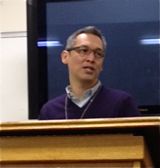 PUBLIC HEALTH CENTER MOVING: White Center’s county public-health center is moving from 8th Avenue to Greenbridge, and David Reyes came to tell NHUAC more about that. The new location will continue to provide some but not all of the services will move with the location – such as public-health-nurse home-visiting services (the Nurse/Family Partnership), he said – there’s no room in the new facility for that team, but the team will continue to serve the area. 34 or 35 staffers will move, about two-thirds of its current staff, Reyes said. The new location is in two storefronts south of Dubsea Coffee on 8th SW; the street number likely wll be 9930, he said. The new design is being finalized, according to Reyes, and “if all goes well … we’re hoping to be able to relocate sometime in June.” He says the space will be environmentally and ergonomically appropriate, and will be able to capture “as much light as possible” – “very different from what we have now” on the current site next to the White Center Food Bank. “It’s going to be like walking into a new doctors’ facility almost anywhere.” The facility’s service area is beyond White Center, by the way – as far south as Des Moines, as well as points east to South Park. Asked by NHUAC member Ron Johnson about the financial arrangements for the new location, Reyes said he didn’t have all the information; Johnson had noted that the space in question was supposed to be for businesses and said he’s particularly concerned if tax revenues – such as those that a business would have provided – were going to be lost. Reyes said he does know that they’re going in as tenants, “not necessarily (tax) exempt.”
PUBLIC HEALTH CENTER MOVING: White Center’s county public-health center is moving from 8th Avenue to Greenbridge, and David Reyes came to tell NHUAC more about that. The new location will continue to provide some but not all of the services will move with the location – such as public-health-nurse home-visiting services (the Nurse/Family Partnership), he said – there’s no room in the new facility for that team, but the team will continue to serve the area. 34 or 35 staffers will move, about two-thirds of its current staff, Reyes said. The new location is in two storefronts south of Dubsea Coffee on 8th SW; the street number likely wll be 9930, he said. The new design is being finalized, according to Reyes, and “if all goes well … we’re hoping to be able to relocate sometime in June.” He says the space will be environmentally and ergonomically appropriate, and will be able to capture “as much light as possible” – “very different from what we have now” on the current site next to the White Center Food Bank. “It’s going to be like walking into a new doctors’ facility almost anywhere.” The facility’s service area is beyond White Center, by the way – as far south as Des Moines, as well as points east to South Park. Asked by NHUAC member Ron Johnson about the financial arrangements for the new location, Reyes said he didn’t have all the information; Johnson had noted that the space in question was supposed to be for businesses and said he’s particularly concerned if tax revenues – such as those that a business would have provided – were going to be lost. Reyes said he does know that they’re going in as tenants, “not necessarily (tax) exempt.”
WHAT ABOUT THE HEALTH CENTER’S CURRENT SITE? It will formally revert to being a King County Parks property, according to Katy Terry from that department. The WC Food Bank is five years into a 15-year lease on its part of the site, she noted. Nothing specific is finalized yet but she says they are interested in having “someone” there, not just having it be some kind of “Parks-specific” space. Maybe a combination of medical – she mentioned a tentative inquiry from Harborview, for example – and nonprofit, she said. They haven’t done outreach yet, she said, while waiting to find out about Public Health’s timetable for moving out, which just now, she said, is starting to become clearer. The Food Bank might even be interested in the added space, she said – if any group is interested in the space, it should contact KC Parks. Answering council questions, she acknowledged this is “new territory for us,” as Parks has not previously had facilities it owned but leased out. Community member Gill Loring asked Terry if they have been officially in contact with Burien, considering the site could be within that city’s boundaries; her answer basically was “no,” though Parks, she says, has been monitoring the annexation situation.
CRIME (ETC.) UPDATE: Storefront Deputy BJ Myers said there was one bit of particularly good news – a lower level of crime in the downtown area last month. He noted that Metro Transit Police have “had a good presence” in White Center, checking out bus stops and making rounds on biccyles. He also said that ex-Storefront Deputy Jeff Hancock “is now a regular presence on patrol on second shift … and has been a great resource to have back.” Myers brought up the Seattle Roll Bakery murder and said the suspect was even arrested and jailed before he came to work that day. “Talking to people around the community, I think there’s an understanding that it’s the kind of crime that could happen anywhere,” he observed. “It just happened to go down in our neighborhood.” Dobkin said she had previously not been aware that the bakery had been open all night; Myers said that wasn’t common knowledge before and that the description in some venues of a “24-hour sandwich shop” wasn’t actually the case – that the bakery had employees on hand at that hour because they were baking for clients, not doing retail business. Would the witnesses who made up the robbery story be prosecuted? he was asked. He said that’s not clear, pointing out that they were in a “difficult position,” but at least, he said, the truth became clear fairly quickly and didn’t set the investigation back too far. What’s up at the DK Café? he was asked (following last fall’s raids). It’s still open, Myers noted, while saying that there’s followup to come. The task force also is still interested in tips, he clarified, but if there’s some “new” or “persistent” crime, KCSO would like to get tips on that kind of thing. Asked about recent crimes, he said that detectives are developing leads on last month’s liquor-store robbery (WCN coverage here). As for this morning’s hit-and-run, he says they’re now confirming it was believed to be a “dark sedan,” though originally there was “no vehicle description at all.” He also fielded questions about various other concerns, including whether people are back living in the apartments over the former Club Evo; they seem to be, he said.
QUARTERLY CRIME DISCUSSION? NHUAC member Richard Miller, who also happens to chair the West Seattle Crime Prevention Council, said he had been talking to the brass at KCSO about a possible quarterly meeting to discuss crime issues/concerns, separate from NHUAC meetings, which tackle a variety of topics. A date of 7 pm February 9th was tentatively set for a pilot version of this meeting.
BURIEN UPDATE – INCLUDING ANNEXATION AND LIBRARY CONSOLIDATION: Burien city manager Mike Martin said he’ll be at next Monday’s Boundary Review Board meeting on the annexation proposal (7 pm January 9th at Cascade Middle School), missing a Burien City Council meeting – the first one, he says, he’s ever missed – in order to be present. He says no 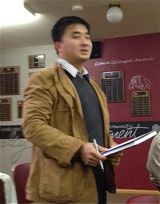 surprises are expected. … He gave a shoutout to new staffer Nhan Nguyen (left), who (as mentioned at a previous meeting) is now a management analyst for Burien … Then he talked about the library controversy. “You probably don’t know we’ve put together a little ad-hoc group,” Martin said, including NHUAC president Barbara Dobkin, to focus on the issue; it met most recently, he said, last night. “We really tried to dissemble the whole thing and see ‘what makes sense’,” Martin explained. Rather than just oppose the consolidation plan, Martin said, they want to be able to tell the county library system what they think SHOULD happen. He said “a couple themes have emerged” – that the Boulevard Park Library “is a unique facility and serves a function greater than being a library – it’s a gathering spot, it’s iconic, it’s the sole representative of government there …” So, he says, there’s probably “no compromise” that the Boulevard Park Library must stay open in some form, at its location. So, he said, the group is now focusing on the White Center Library, with a lot of discussion focusing on it also having importance beyond just being a library – being “community-centric.” The location, though, may not be so important, so they’re talking about whether other sites might make sense. And, he says, they are taking into account such things as “what if Seattle annexed that area in 10 years?” even though that seems unlikely, at the very least. Factors they are evaluating include social justice and economy of scale, and whether the building of a White Center Library could serve some other function. Bottom line, though, he said, the group has reached “no conclusions,” in its “free-ranging, candid” discussions thus far. Martin reiterated that he doesn’t want to just “stop the (consolidation) project,” but rather put forward an alternative proposal. NHUAC member Ron Johnson brought up the matter of proximity to schools; Martin said there are even better places a library could be than its current site, if that is a key issue. (If you’ve missed previous coverage of the issue, the library board decided to table the consolidation discussion until after the Boundary Review Board makes its decision on furthering the annexation proposal, after next week’s hearing. The board’s next meeting is January 24th; no agenda is posted yet.) Dobkin noted that a location closer to downtown White Center might be optimal; while that has in the past stirred concern that it was too close to Seattle, Martin pointed out the possibilities of economic spinoff – he consulted Nguyen for a bit of data, that 35,000 people from Seattle use county libraries in this area, and what if they all also came to patronize the White Center business district while doing that – “seeing those business rising” during their visits?
surprises are expected. … He gave a shoutout to new staffer Nhan Nguyen (left), who (as mentioned at a previous meeting) is now a management analyst for Burien … Then he talked about the library controversy. “You probably don’t know we’ve put together a little ad-hoc group,” Martin said, including NHUAC president Barbara Dobkin, to focus on the issue; it met most recently, he said, last night. “We really tried to dissemble the whole thing and see ‘what makes sense’,” Martin explained. Rather than just oppose the consolidation plan, Martin said, they want to be able to tell the county library system what they think SHOULD happen. He said “a couple themes have emerged” – that the Boulevard Park Library “is a unique facility and serves a function greater than being a library – it’s a gathering spot, it’s iconic, it’s the sole representative of government there …” So, he says, there’s probably “no compromise” that the Boulevard Park Library must stay open in some form, at its location. So, he said, the group is now focusing on the White Center Library, with a lot of discussion focusing on it also having importance beyond just being a library – being “community-centric.” The location, though, may not be so important, so they’re talking about whether other sites might make sense. And, he says, they are taking into account such things as “what if Seattle annexed that area in 10 years?” even though that seems unlikely, at the very least. Factors they are evaluating include social justice and economy of scale, and whether the building of a White Center Library could serve some other function. Bottom line, though, he said, the group has reached “no conclusions,” in its “free-ranging, candid” discussions thus far. Martin reiterated that he doesn’t want to just “stop the (consolidation) project,” but rather put forward an alternative proposal. NHUAC member Ron Johnson brought up the matter of proximity to schools; Martin said there are even better places a library could be than its current site, if that is a key issue. (If you’ve missed previous coverage of the issue, the library board decided to table the consolidation discussion until after the Boundary Review Board makes its decision on furthering the annexation proposal, after next week’s hearing. The board’s next meeting is January 24th; no agenda is posted yet.) Dobkin noted that a location closer to downtown White Center might be optimal; while that has in the past stirred concern that it was too close to Seattle, Martin pointed out the possibilities of economic spinoff – he consulted Nguyen for a bit of data, that 35,000 people from Seattle use county libraries in this area, and what if they all also came to patronize the White Center business district while doing that – “seeing those business rising” during their visits?
COUNCIL ANNOUNCEMENTS: President Barbara Dobkin reminded everyone about the Boundary Review Board meeting, noting that the board will be ready to hear public comment; on behalf of the council, Dobkin plans to speak in favor of the annexation proposal … NHUAC member Pat Price reminded everyone of the White Center-South Delridge Community Safety Coalition’s emergency-preparedness series launching next week …
PUBLIC COMMENT: 7 pm January 24 is the next North Highline Fire District commissioners’ meeting … Aileen Sison thanked everyone who contributed to last month’s Tree LIghting Ceremony at the Delridge Triangle, noting that about 100 people were in attendance (WCN coverage, with video, is here); she mentioned the tree-topper designed by the local blacksmith who also has created the bike racks now appearing in downtown White Center.
DOWNTOWN FLOWER BEDS, AND STEVE COX MEMORIAL PARK FLAG: Dobkin says their adviser on the project, Village Green Perennial Nursery’s Vera Johnson, says they could plant now, so she’ll be organizing a work party. Council member Rebecca Lopes talked about the flagpole at Steve Cox Memorial Park, which also will need a flag. Johnson suggested obtaining a flag that has flown over the State Capitol. Other ideas for flag sources were discussed. Whatever the ultimate result, Dobkin said, she thinks it would be appropriate for NHUAC to have something to do with providing the flag, given the group’s history with renaming the park in honor of Deputy Cox and his long NHUAC involvement.
COUNCIL BYLAWS – INCLUDING, WILL THERE BE AN ELECTION? These are more important than you might think, given that the group’s no longer funded and convened by the county, but has decided to go ahead TFN. That raised the question of whether they should proceed with May elections as usual. Member Price suggested that elections be tabled while they wait to see what happens with annexation, provided the current members are amenable to continue their roles at least through 2012. Dobkin pointed out that elections require a lot of effort, and haven’t drawn major turnout. If annexation falls through, then they’ll have to decide what to do, as Johnson observed, but for now, the council voted unanimously to put elections on hold, at least until there’s word on whether Burien will take the annexation proposal to voters.
The North Highline Unincorporated Area Council meets the first Thursday of the month, 7 pm, at North Highline Fire District HQ, 1243 SW 112th SW.
Update: Man seriously hurt in hit-run crosswalk crash
January 5th, 2012 at 3:06 am Posted in King County Sheriff's Office, White Center news | 2 Comments »
3:06 AM: Got a text asking why police tape is up in the 14th/15th/Roxbury vicinity. We get the answer from our friends at KING 5, who say a 55-year-old man was seriously hurt when a vehicle hit him in the crosswalk there. Their photographer’s photo, shared on Twitter, shows the 16th/Roxbury intersection blocked off.
3:32 AM UPDATE: KING quotes investigators as saying the driver may have come off Delridge before the collision.
10:31 AM UPDATE: We have an update from Sgt. Larson at the King County Sheriff’s Office:
At approximately 01:43, the victim was crossing Roxbury at 16th Ave. SW. He was walking southbound, and he was in a crosswalk. A dark colored sedan was making a left turn from southbound 16th Ave. to eastbound Roxbury. The vehicle struck the victim and then continued driving without stopping. The fleeing vehicle will have a broken driver’s side mirror.
The victim, a 54 year old Seattle man, was transported by medics to Harborview Hospital with critical injuries.
The King County Sheriff’s Office Major Accident Reconstrution Detectives are investigating. Anyone with information about this crime is asked to call the King County Sheriff’s office at 206.296-3311.
Update: Missing teenager turns out to be safe after all
January 4th, 2012 at 2:11 pm Posted in How to Help, White Center news | 2 Comments »
UPDATE: The teenage boy reported earlier as missing apparently had been safely found even before authorities put out the call for help – King County Sheriff’s Office spokesperson Sgt. John Urquhart says someone found him by a road late this morning and took him to Harborview Medical Center, and due to the communications challenges of his autism, it took a while before everyone realized who he was. Bottom line, he’s OK and safe. Our original story is after the jump: Read the rest of this entry »
King County Sheriff’s Deputies getting life-saving devices
January 4th, 2012 at 12:57 pm Posted in Health, King County Sheriff's Office, White Center news | Comments Off on King County Sheriff’s Deputies getting life-saving devices
Announced today by the King County Sheriff’s Office:
In partnership with King County Emergency Medical Services, a division of Public Health – Seattle & King County, 53 Automated External Defibrillators (AEDs) are being distributed to 53 King County Sheriff’s Deputies. The deputies can be dispatched to a cardiac arrest call along with emergency medical responders.
Equipped deputies who arrive first to the scene of a cardiac arrest will start resuscitation and deliver the first defibrillator shocks. Once emergency medical responders arrive on the scene, they will take over resuscitation duties.
“Training and equipping Sheriff Deputies with external defibrillators is a great service for all residents in King County and will definitely save lives. Rapid defibrillation can literally snatch the life from the jaws of death,” said Dr. Mickey Eisenberg, the Medical Director for King County Emergency Medical Services.
15 deputies have already been trained and are equipped with AEDs. The remainder of the AEDs will be assigned over the next few months as deputies receive the training. “This is a voluntary initiative and all deputies receiving an AED have expressed their interest in participating in this life-saving program,” said King County Sheriff’s Captain Bryan Howard, who is the Emergency Services Coordinator for the Sheriff’s Office.
Public Health provided the funding for approximately 49 of the AEDs. The EMS levy funding is available for special projects related to training for King County and region-wide municipal workforce and providing AEDs for King County facilities and vehicles.
“Seattle and King County already have the best survival chances for cardiac arrest in the country, thanks to Medic One and CPR/AED training for our residents,” said King County Councilmember Kathy Lambert, who chairs the Security Oversight Committee and advocates for AEDs. “Our Sheriff’s deputies often arrive first at the scene of an emergency, and they are already trained to save lives. These AEDs are important tools to have available in the field so we can get help quickly to where it is needed. Recent placement of AEDs in the King County Courthouse already has saved at least one life, and now we can expand this capability throughout the community.”
